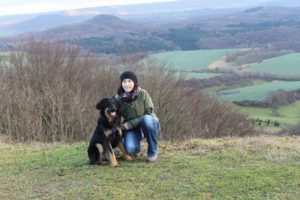Dr. med. vet. Christin Habig, Ph.D.
Since graduating in veterinary medicine in 20 10 I worked in the field of poultry science. From 2010 to 2013 I did my doctoral thesis at the Institute for Animal Breeding and Genetics, University of Veterinary Medicine Hannover. The aim of my thesis was to evaluate whether and to what extend different group sizes and tiers of the small gro
10 I worked in the field of poultry science. From 2010 to 2013 I did my doctoral thesis at the Institute for Animal Breeding and Genetics, University of Veterinary Medicine Hannover. The aim of my thesis was to evaluate whether and to what extend different group sizes and tiers of the small gro
up housing system Eurovent German affect certain phenotypic traits and gene expression profiles in two lines of laying hens. Within the scope of my doctoral thesis I already assessed keel bone deformities by palpation and measured bone breaking strengths of Lohmann Selected Leghorn and Lohmann Brown laying hens.
In 2012, I left the Institute for Animal Breeding and Genetics and worked at the Institute for Animal Hygiene, Animal Welfare and Farm Animal Behaviour, University of Veterinary Medicine Hannover. During that time, I mainly worked in the field of poultry welfare, but I also supervised several projects regarding animal- and environmental hygiene.
– Current work with Keel Bone Damage –
With regard to keel bone damage I compared the keel bone status of male layers, dual purpose males and mixed sex broilers during an 11-week fattening period. Moreover, I trained some of our doctoral students in palpation of the keel bone. At the university I was strongly involved in teaching students and trainees of the poultry sector. I gave several lectures, particularly on poultry husbandry and current animal welfare problems.
At present, I am working at the Friedrich-Loeffler-Institut, Institute of Farm Animal Genetics on a project comparing relatively unselected with current commercial lines of hen to understand how selection has played a part in bone stability, including keel bone development and its susceptibility to damage. In the framework of the COST Action ‘CA 15224 – Identifying causes and solutions of keel bone damage in laying hens’ I did a ten-day, Short Term Scientific Mission (final report available here) at the Roslin Institute, University of Edinburgh, in February 2017. This was a great chance and experience for me. During the two weeks at the Roslin Institute I gained a lot of knowledge and training in bone morphology and bone quality assessment.
Outside of work, I like to go on long hikes, especially with my parent’s dog, enjoy travelling and meeting my friends.


